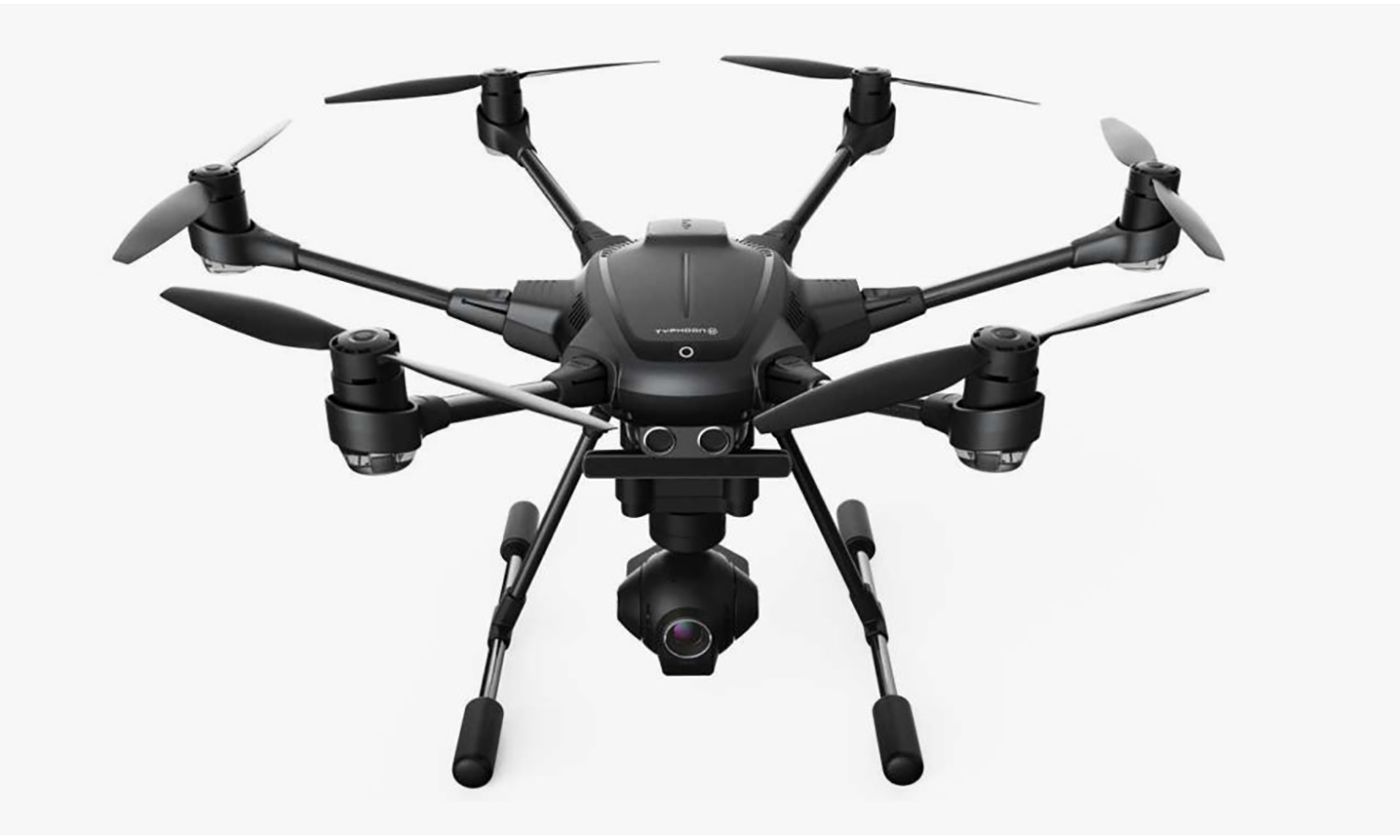Tom's Guide Verdict
The Typhoon H is an innovative, easy-to-fly drone that offers a lot of features for the serious drone video maker.
Pros
- +
Easy to use controller and big, bright video preview
- +
Offers plenty of speed and maneuverability
- +
Excellent video and photo quality
- +
360-degree camera pan offers more flexible shooting
Cons
- -
Collision avoidance only detects objects right in front
- -
Slight lag in video preview
Why you can trust Tom's Guide
If you are serious about taking high-quality airborne video, you need a drone that offers serious quality and flexibility. The Typhoon H is the latest model from Yuneec for the high-end drone user, shooting very high quality 4K video and offering a lot of features. Relatively quiet operation, a 360-degree pannable camera and a big-screen HD video preview are among the features on offer in this attractive package.
Design
Looking like a matte black flying insect, the Typhoon H is a large, but lightweight drone. It uses six engines to fly, two more than the usual quadcopter, with the idea being that more engines means more control. Each of the six engines is on the end of a 9-inch carbon fiber arm that folds up when not in use, making the hexacopter smaller and easier to store. When you want to fly, the arms fold up and lock in place.
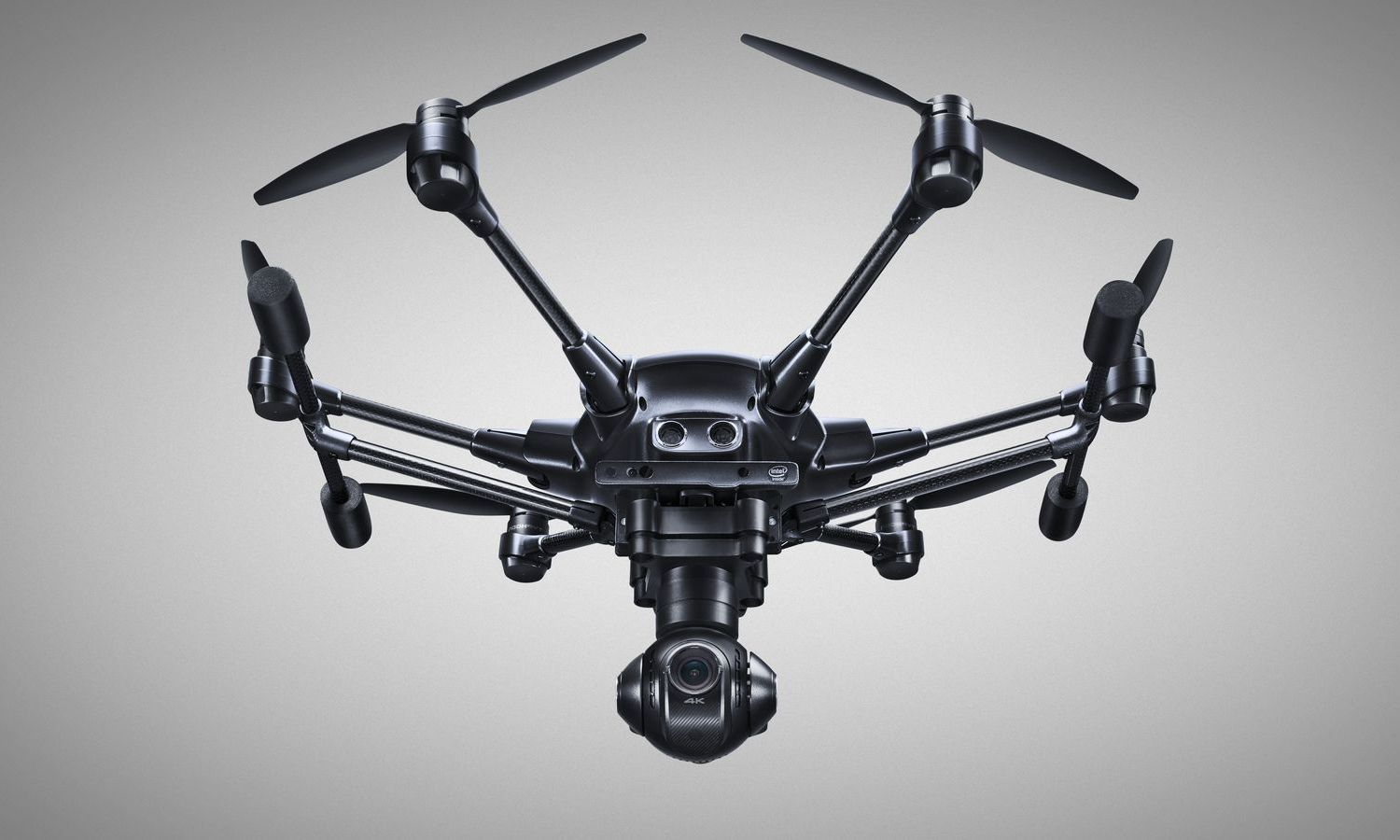
In flying position, the hexacopter measures 28.5 inches from blade tip to blade tip, and about 13 inches from blade top to landing gear.
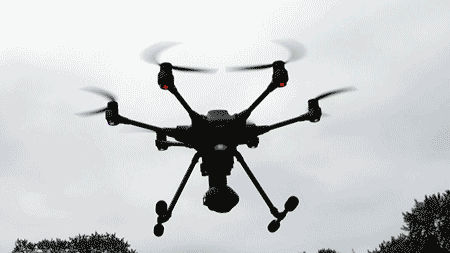
It folds down to about 11 x 11 x 11 inches for storage (not including the rotor blades, which have to be removed), so it could be stored in a large backpack. The hexacopter is pretty light, though, thanks to the use of carbon fiber: the takeoff weight is 4.3 pounds, complete with the large 5400 mAh battery. (That’s about a pound heavier than the DJI Phantom 4) The controller adds about 2.6 pounds to this, so it is quite light for a drone of this size. All of this comes in a tough foam box that can be used with an appropriately-sized backpack as a portable drone kit.
The Typhoon H’s battery slips into the center body of the drone, which houses all of the electronics. The Typhoon H includes a collision avoidance system, which uses an ultrasonic rangefinder to detect objects ahead of the drone and stop it. Yuneec also offers a model that includes an Intel RealSense camera system for mapping and avoiding obstacles, but our test model did not include this. This model (called the Typhoon H Pro) costs an additional $600.
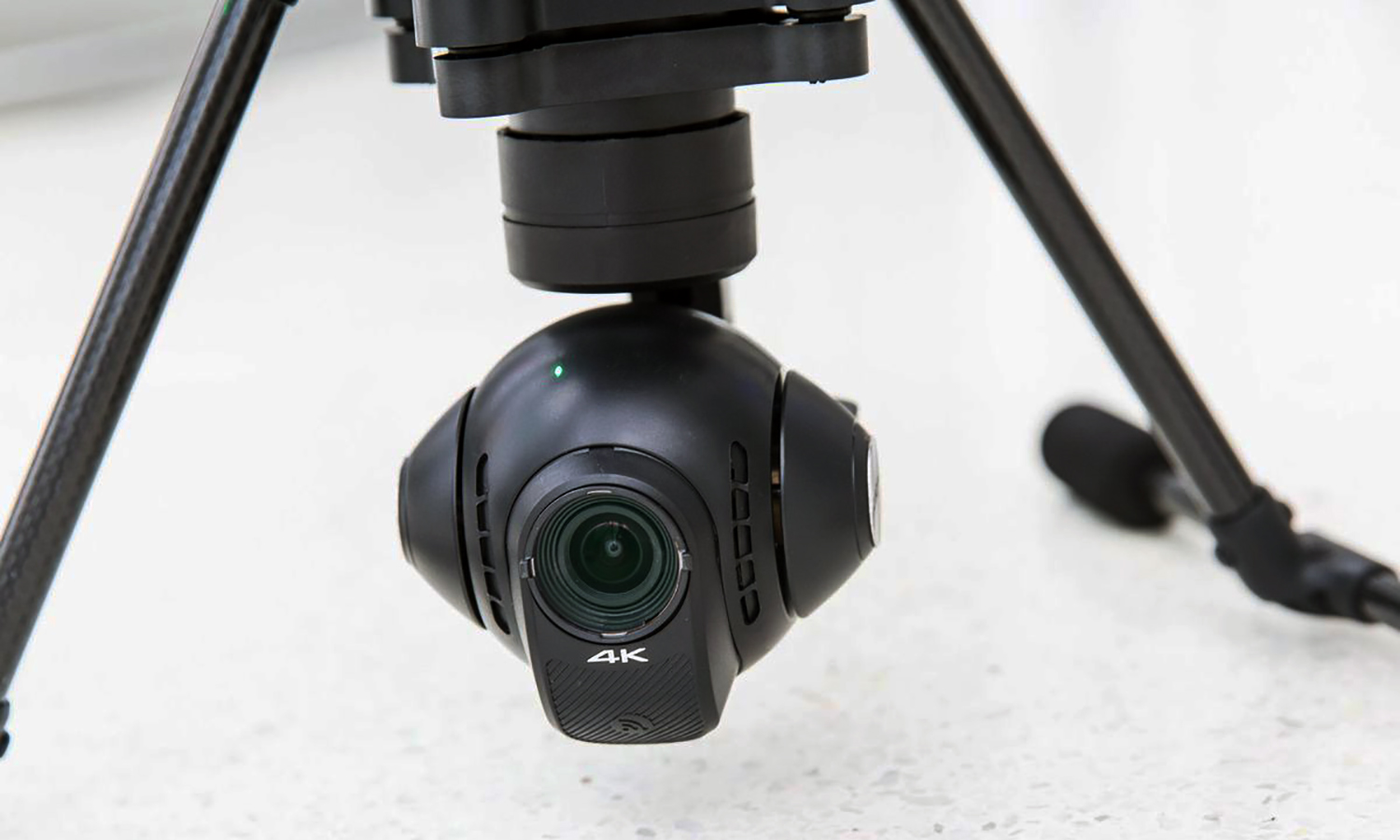
The landing gear is also made of carbon fiber, and has an unusual feature: after the drone has taken off, it folds up with the flick of a switch against the body. This makes the Typhoon H a little more aerodynamic and gives the camera under the drone body an uninhibited 360-degree field of view: unlike other drones, the camera can rotate all the way around with a view unobscured by the legs of the drone. This definitely makes shooting pans easier: rather than rotating the entire drone, you can just rotate the camera for slower and more subtle shots.
MORE: The Best Drones and Quadcopters on Any Budget
The camera and gimbal attach to the base of the drone body, with rubber joints that stop vibrations from the rotors reaching the camera. The gimbal can rotate a full 360 degrees, and tilt the camera up by 10 degrees, or right down to look directly below. The camera itself is spherical and 3.5 inches in diameter. Most drone cameras look like GoPros, but the CS3 camera here looks a lot like one of the EVA pods from 2001: a Space Odyssey, although hopefully without the murderous tendencies. The micro SD card that holds the recorded video fits into the back of the camera body. The video files are saved as MP4 files, and at the highest resolution, the included 16GB micro SD card can hold about 45 minutes of video.

Specs
Rotors: 6 (2 blades per rotor) replaceable, 9.25-inch diameter
Battery Size: 14.8V 5400-mAh Li-ion, removable
Battery Life: 23/25 minutes (claimed/tested)
Camera: CGO3+, up to 4096 by 2160(24fps) or 30840 by 2160 (30fps)
Smartphone Controlled: No, Android controller
FAA Registration: Yes
Size: 10.5 x 12 x 11 in (folded), 28.5 x 28 x 13 (flight config, rotor tip to rotor tip)
Weight: 4.3 pounds
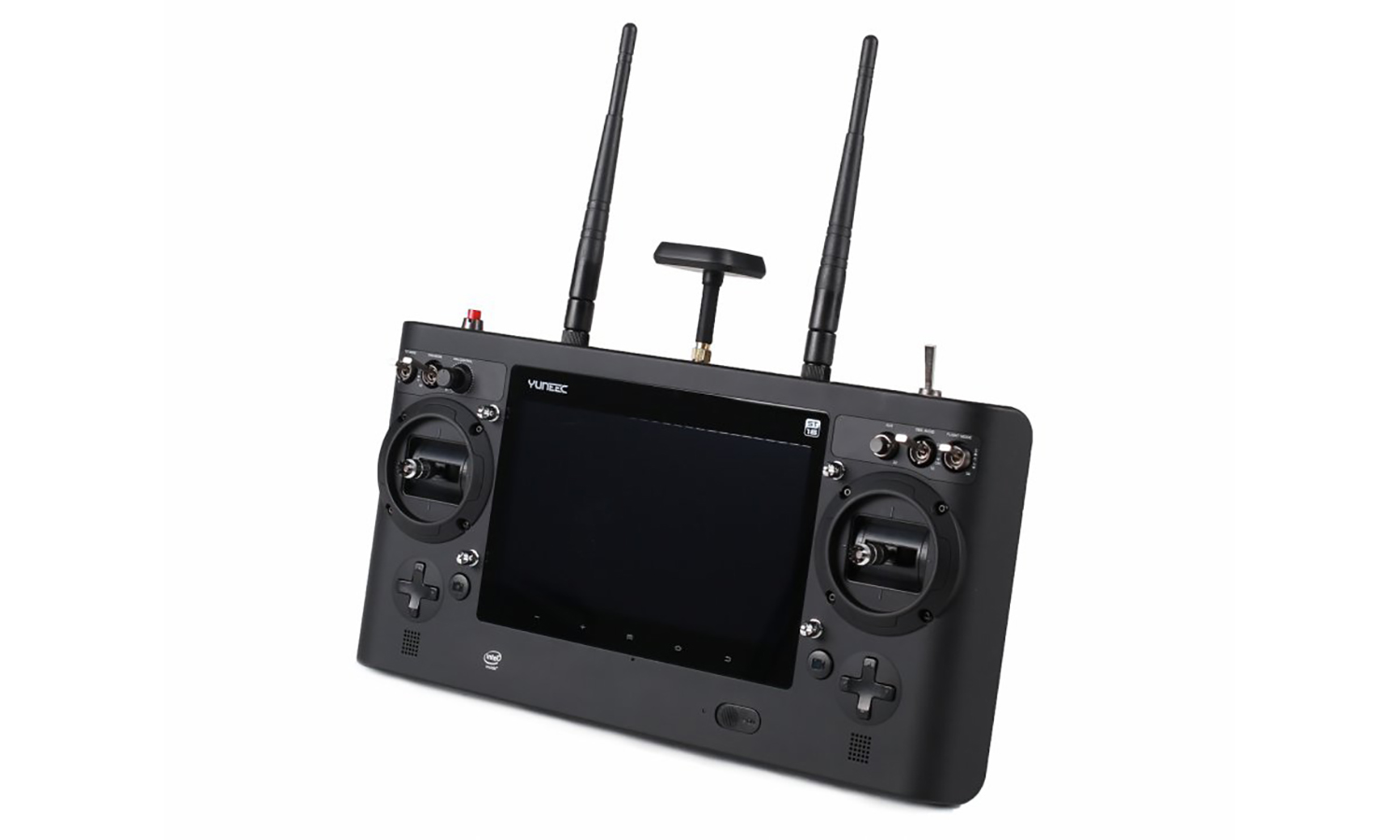
Controller
The ST16 controller is a hefty device, measuring a little more than 13 inches long and 7 inches wide. Fortunately, it is fairly light (weighing 2.6 lbs) and comes with a neck strap that holds the weight. It’s a pretty powerful device, running a custom version of the Android OS on an Intel processor. This means that you don’t need (or want) a smartphone or tablet to fly the Typhoon H: everything is done from the controller.
Although it is large, the controller fits in the hand well, with two grips on either side. It is bristling with buttons and dials: I counted five buttons, five switches and three dials, not including the control sticks and the directional buttons below them. This is enough to give a novice nightmares, but it does keep commonly used controls (such as stopping and starting the motors, starting video and raising and lowering the landing gear) close at hand, and the numerous dials allow you to create smooth tilts and pans with the camera.
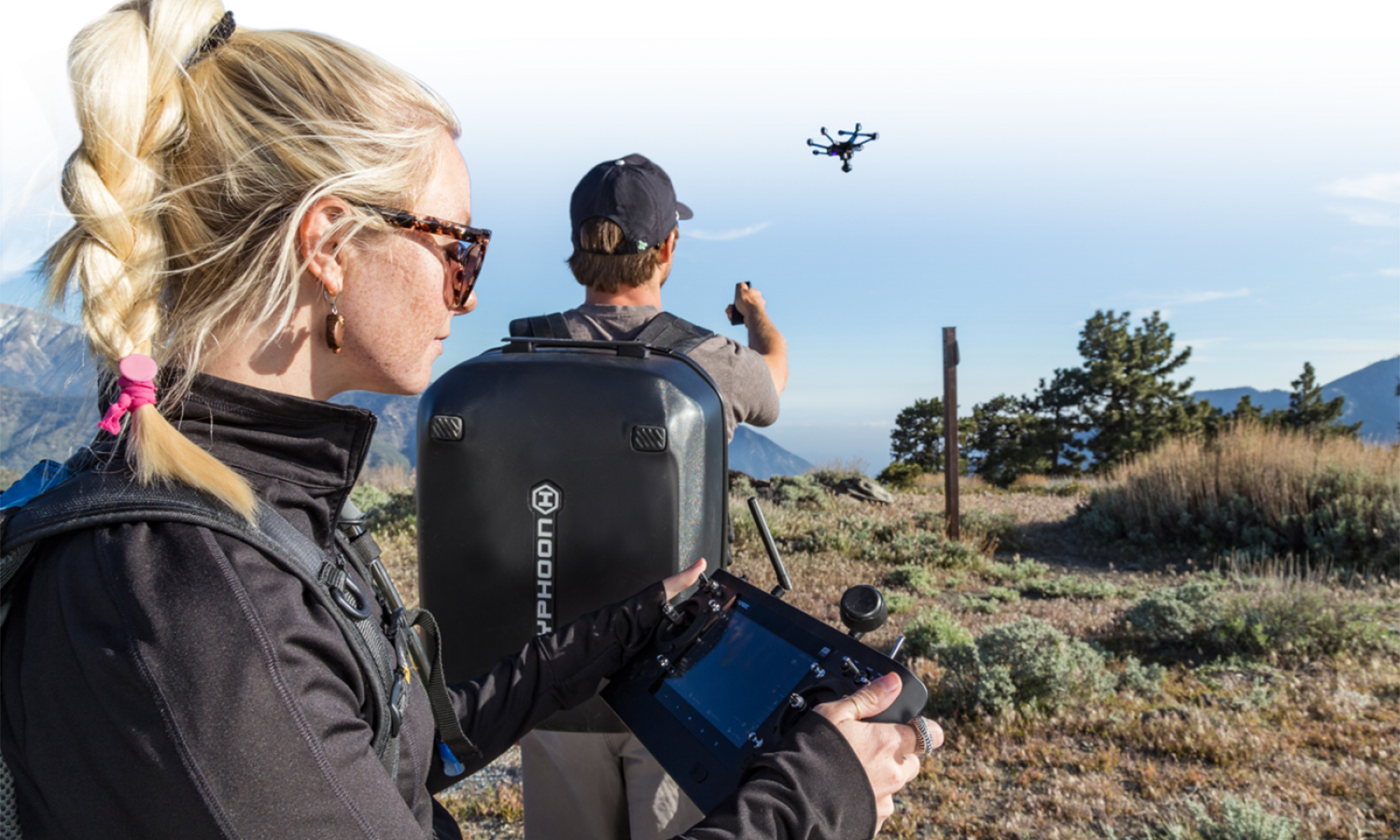
In the middle of the controller, a 7-inch LCD screen shows the preview video and the settings. This puts a lot of info on screen at once, but you can hide this: just tap on the screen and the screen switches to a video preview-only mode. The Typhoon H’s video preview is at 720P high definition — unusual since most other drones send only a standard definition or lower-resolution preview to the controller or connected device. This gives you a much better sense of what the final video will look like, which makes it easier to spot problems while shooting.
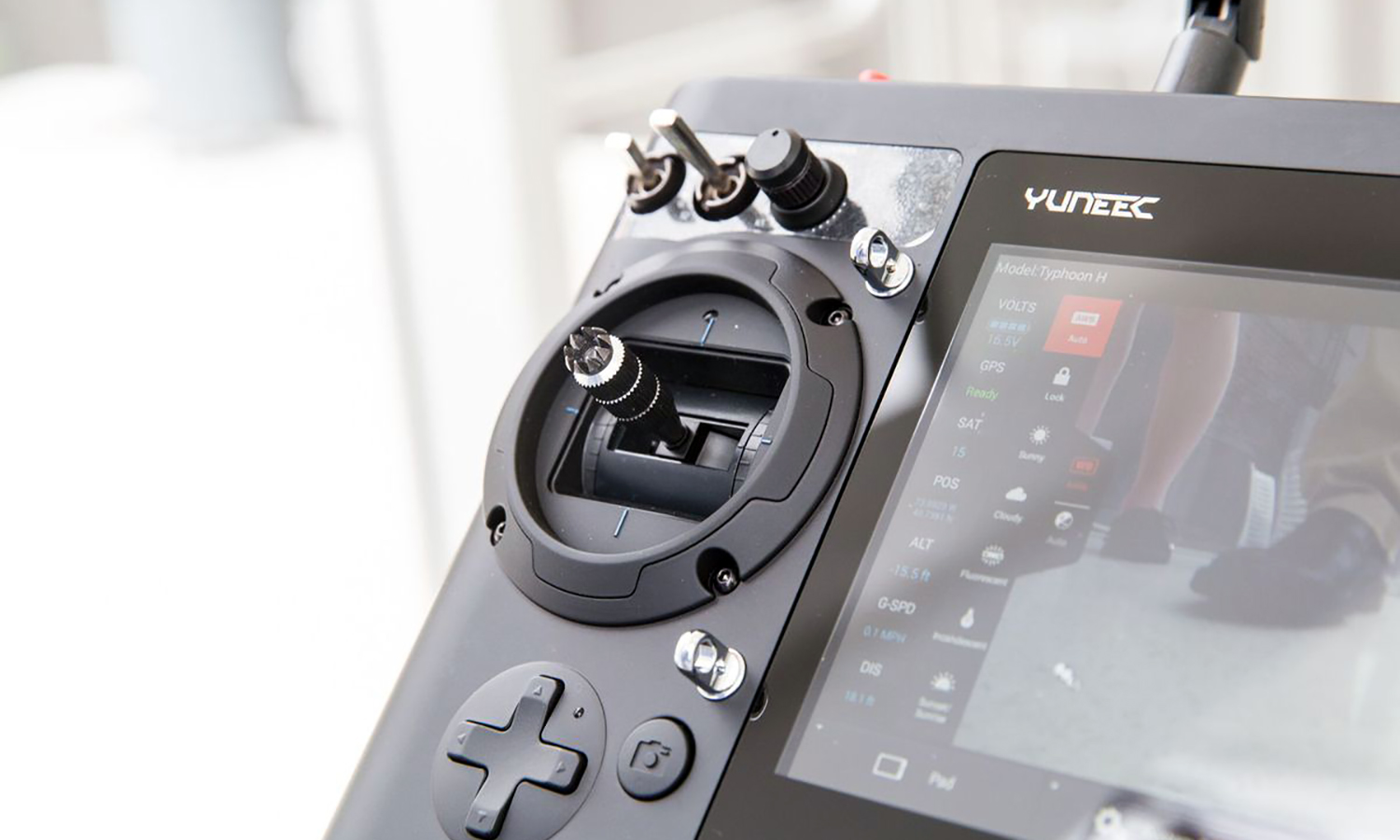
There are two antennas on the top of the controller, one for the radio control signal, and another for the video preview. Both use signals in the 5Ghz frequency range, which Yuneec claims will work over a range of up to a mile away. I didn’t go quite that far, but had no problems maintaining control and receiving a video preview from a couple of hundred meters away, considerably further than most drones.
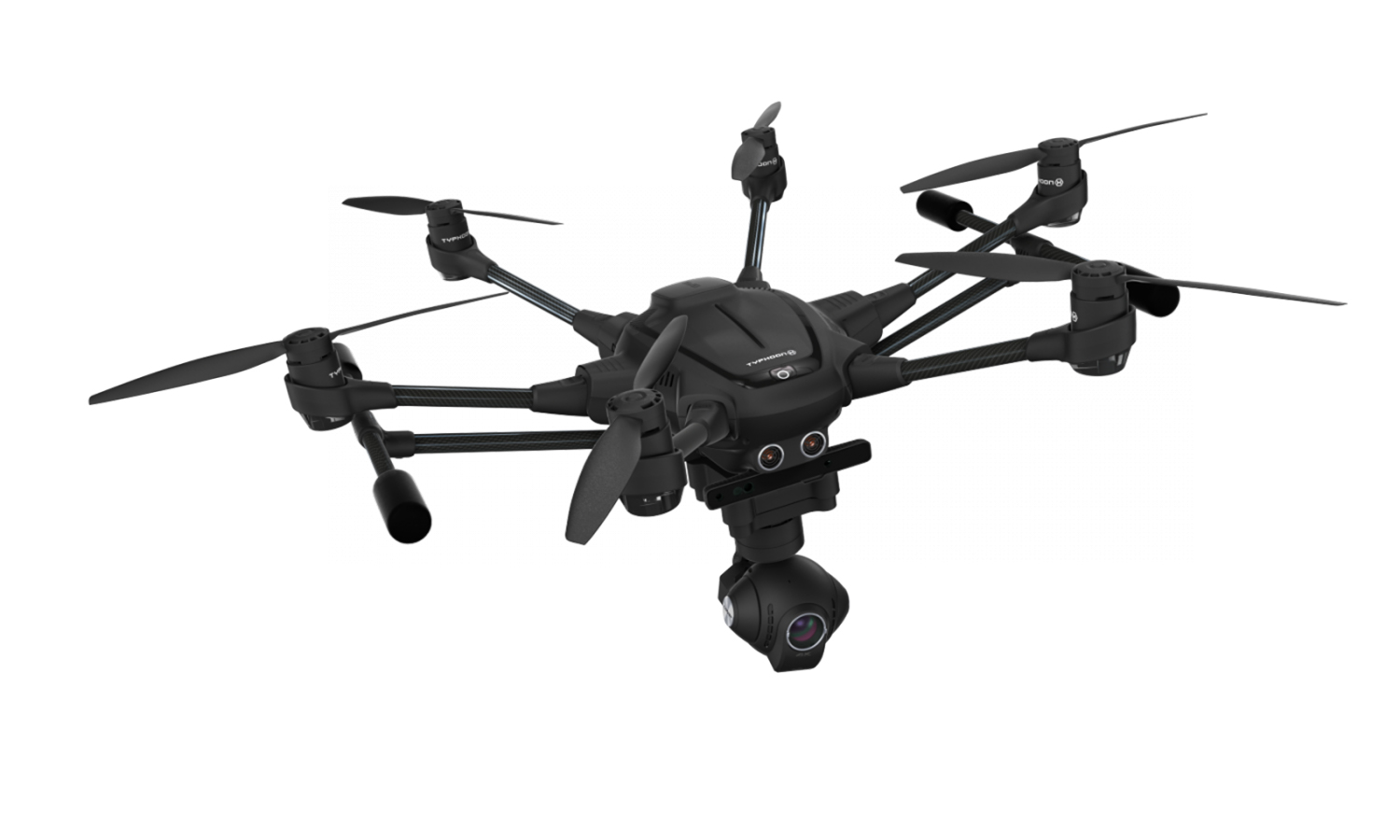
Flying
The Typhoon H is a fun drone to fly, responding quickly to the controls and offering plenty of speed. Yuneec claims the drone can manage a little over 40 miles per hour, and that sounds about right. It’s not a racing drone, but it can get around at speed. It is also quieter than many other drones, producing less distracting noise while hovering. It isn’t a stealth device, though: the noise is still enough to alert local wildlife to its presence.
The controls are sensitive, making it easy to execute moves like slow turns or gentle climbs that make for nice looking video. Separate controls on the front and back of the controller pan and tilt the camera: you can tilt without moving your hands from the control sticks, but a pan requires you to let the control stick go.
MORE: The Best Places to Fly Drones in the U.S.
The Typhoon H requires a bit more preparation for flying than most drones. On most drones, you just unpack and fly, but the Typhoon H requires you to unfold the arms, making sure they are locked into place, before you install the six rotor blades. It’s not difficult, but it makes getting ready take longer. The big red button on the left shoulder of the controller starts the motors, and a touch of the left stick lifts off.
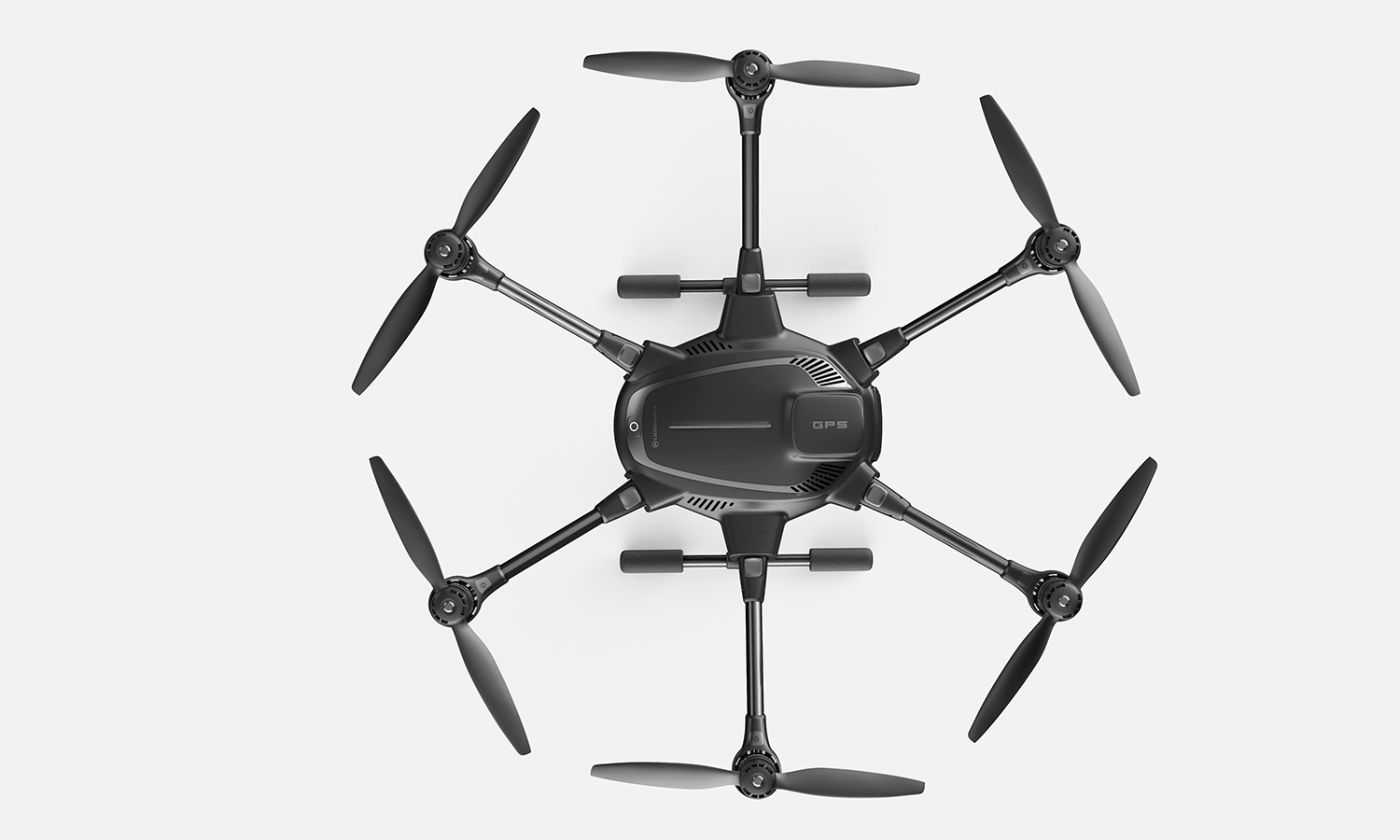
Once in the air, the Typhoon H hovers steadily, awaiting your commands. This does require a strong GPS signal, though: if the satellites are blocked or the drone didn’t get a strong enough location fix, it does bounce around a little, shifting as the GPS fix updates. With a clear sky, both the drone and the controller acquired a strong GPS fix in less than 30 seconds, though.
One interesting feature of the Typhoon H is the ability to fly with a damaged rotor: Yuneec claims that if one rotor breaks, the drone will notice and adjust, compensating for the lost rotor.
When flying the Typhoon H, we did find a slight delay in the video preview: the process of compressing, sending and decompressing the video means that the preview lags the real world by about half-a-second. That’s not a problem most of the time, but it can be if you are making a close approach to something and are flying from the preview. Most drones have a slight delay, but the delay on the Typhoon H is longer, and requires cautious flying.
The Typhoon H includes a collision avoidance system in the form of an ultrasonic rangefinder on the front of the drone body. When enabled, the drone stops if it detects anything in front of it. I found that it detected even small objects like branches, but only if they are directly in front of the drone. It won’t spot things that are even slightly to the side or alongside the drone.
One interesting feature of the Typhoon H is the ability to fly with a damaged rotor: Yuneec claims that if one rotor breaks, the drone will notice and adjust, compensating for the lost rotor. While this is definitely a nice trick, we found that it wasn’t that useful, as crashes and collisions would usually break more than one of the closely placed rotors. In one instance, we clipped a branch, and the hexacopter immediately began to spin, bringing two other rotors into contact with the branch, breaking them and sending the drone plunging to the ground. The carbon fiber body of the Typhoon H proved to be very strong, though, shrugging off this 10-foot fall without a scratch. However, a second crash proved more of a problem, with a similar fall breaking one of the joints for the landing gear and the gimbal mount.
Autonomous Flying
There are several autonomous flying modes on offer, where the Typhoon H itself does most of the flying: Orbit Me, Point of Interest, Journey, Curve Cable Cam, Follow Me and Return Home.
In Orbit Me mode, the Typhoon H will orbit around the controller, keeping the camera pointed at the operator while it flies around them. The distance and height of the orbit can be set on the controller, and the operator sets the speed of the orbit. The Point of Interest mode is similar to the orbit mode, except it will orbit around a specified location, set by GPS co-ordinates on the controller screen. Again, the radius, height and speed of the orbit can be set by the pilot.
All of the autonomous modes are easy to use and control.
Journey is a drone selfie mode, where the drone will fly out to about 150 feet away from your current location, then fly back in to about 15 feet away, keeping the camera pointed toward the operator to capture their happy smiling face. It’s a fun preset to use if you are sitting on the edge of a cliff or other scenic spot. Curve Cable Cam will create a route between a series of waypoints, orienting the camera as requested along the way. The curve part comes from the way the drone’s software calculates the route, creating a smooth, curved path that the drone will follow.
Follow Me, as the name suggests, will follow the controller at a specified distance, keeping the camera pointing at the controller. Although the large controller isn’t really practical to carry with you on a bike, Yuneec offers another controller: the Wizard, a smaller $140 controller which lacks a screen. The idea is that this TV remote-sized controller is more portable, so it can be put into a bag or pocket and carried around in the Follow Me mode. It has a few simple controls on it for take-off, landing, setting the height and starting the Follow Me mode. It can also be used with the main ST16 controller (Yuneec calls this team mode) where the Wizard controls the drone flight, while the main controller controls the camera. This wasn’t available for testing, unfortunately, but it is definitely an interesting idea for the action sports user, and can now be purchased online or at retailers.
All of these modes are easy to use and control: just tap on the task button on the screen, select the mode from the menu and follow the prompts. The prompts are easy for novices, and can be skipped once you know how to run the modes effectively. We found that these modes worked well, but some were limited. For instance, the Follow Me mode lagged behind when I tried it while walking around holding the controller. It worked fine when I walked in a straight line, but turning direction seemed to confuse it a bit. Presumably, the algorithm the drone uses to track the controller is designed to work with things like a bike or car, which generally keep going in a straight line.
MORE: What the FAA's Drone Rules Could Mean for You
Once you are finished flying, just flip the flight mode switch to H (for home) and the Typhoon H automatically flies to about 30 feet above the home location and lands gently.
Generally, I found the Typhoon H to perform similarly to the Phantom 4 and the 3DR Solo in these modes. All of these use a slightly different approach, but offer a similar set of modes for autonomously flying around to create shots. The Typhoon H has a slight advantage with the 360-degree camera rotation, but all of these drones can be used to take great shots once you figure them out.
Photos & Video
The CGO3+ camera that comes with the Typhoon H can capture excellent quality video at 4K resolution at 30 or 24 frames per second. This video has great quality, with smooth motion and lots of detail, although there is a little electronic noise in the images, and the camera does pick up occasional vibrations from the drone body. These are rare, though, and the drone generally does an excellent job of keeping the camera steady and the video sharp. We preferred the video from the Typhoon H over that captured by the Phantom 4: it was sharper, steadier and smoother in pans and tilts.
The camera hangs underneath the drone body, separated by the gimbal and a series of rubber joints that stop vibrations being transmitted to the camera. The gimbal is unusual in that it can pan a full 360 degrees. Most drones (like the DJI Phantom 4) only offer a limited pan range: to pan around further, you have to rotate the entire drone. When you do pan, the camera often catches sight of the landing legs of the drone. Not so on the Typhoon H: because the landing legs can be raised out of the way, you can take full 360-degree pans by rotating the camera, which produces much smoother rotation than turning the whole drone.
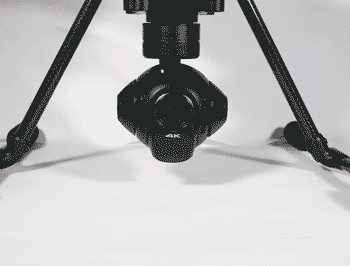
The camera can also tilt straight down, and this extra flexibility makes it a very capable aerial camera for capturing shots like panoramas, rolling landscapes or panning shots where the subject walks across the landscape.
The CGO3+ camera can also take 12-megapixel photos, triggered from the shutter button on the controller. The quality of these photos is generally excellent, but they did suffer from some of the same issues as the video. Low-light shots contained a small (but visible) amount of noise in the shadows and lowlights.
MORE: Why Drone Racing is the Next Big Sport
However, using this drone does lock you into using this one camera. Some drones use third party cameras that can be replaced and upgraded by new models. You can start out on the 3DR Solo, for instance, with a cheap GoPro, then upgrade it to a better one that can shoot 4K video as your budget allows. You can’t do that with the Typhoon H, as you can only use the camera that comes with the drone. That might not be a limitation for most, especially as the CGO3+ camera can shoot up to 4K video, but it might limit the more experimental video maker.
Repairability
The Typhoon H feels a little lightweight in terms of construction and it’s a complicated beast: more parts means more bits to fail. We didn’t have any issues in our testing, though, with complex parts like the fold-out arms and retracting undercarriage performing without problems.
MORE: Drone Buying Guide: Everything You Need to Know
A new set of six rotor blades for the Typhoon H will set you back $30, which is cheaper than most. Installing and removing the rotor blades is very easy: to install you match the color of the center of the rotor with the top of the motor (white or black) push it into place and then twist the rotor to lock it in, which it does with a satisfying click. To remove a rotor, just press the button on top of the motor and twist the rotor in the reverse direction. It’s a very simple system that is quick and easy to use, but which also makes sure that the rotor is properly installed.
Battery Life
Yuneec claims a battery life of up to 25 minutes from the large 5,400 mAh battery, and I found that to be about right: I typically got between 20 and 25 minutes from a full charge, depending on how hard I was flying.
The Typhoon H comes with a single battery, and a charger that can handle one battery at a time. This took a long time to fully charge, usually about an hour and 45 minutes. One interesting feature is the inclusion of a cable that can charge the battery from a car lighter: I haven’t seen this handy feature included with a drone before. The charger also has a USB port that can charge the controller, or another USB device. Spare batteries for the Typhoon H cost about $130 each, which is average for larger drones like this.
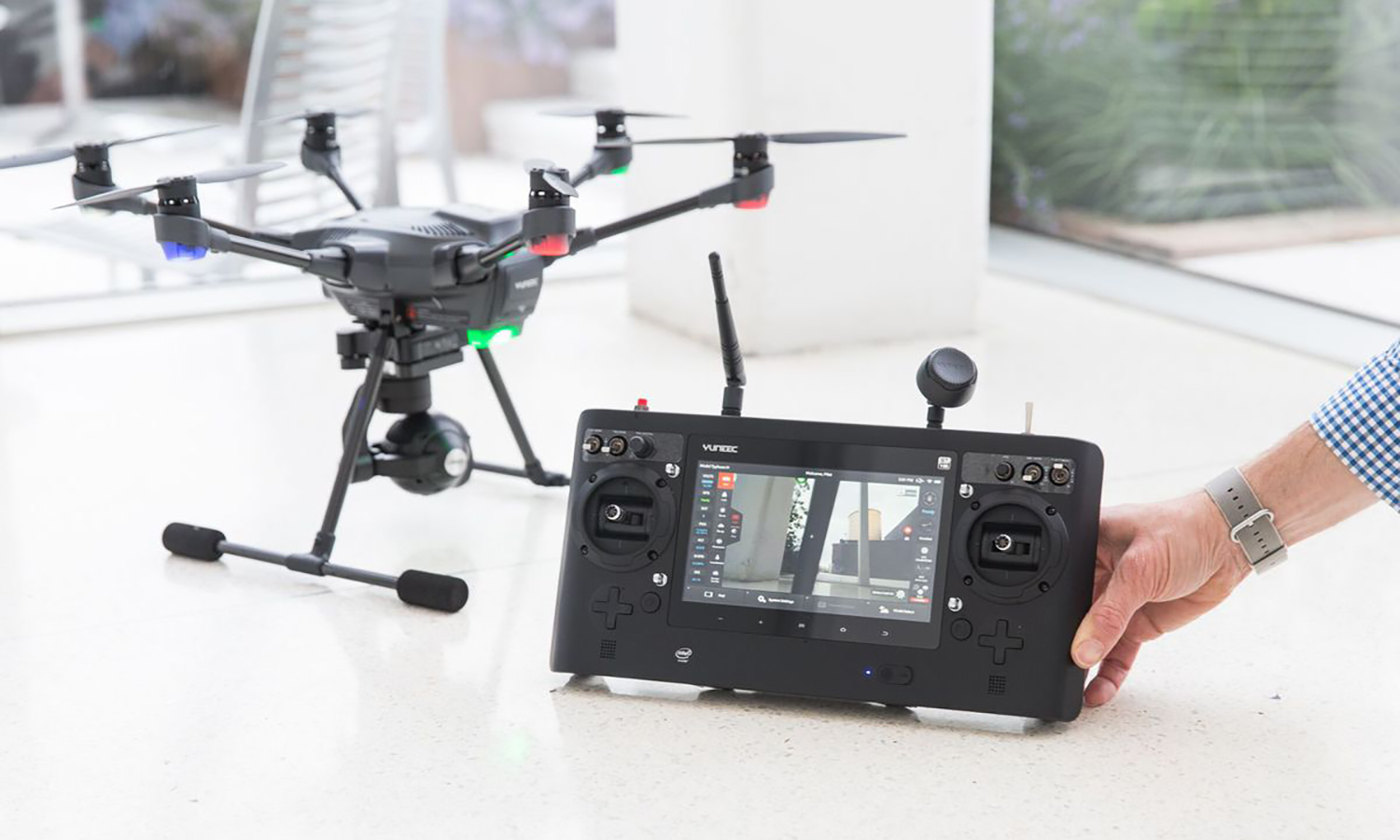
Bottom Line
The Typhoon H has a lot to offer the aerial movie maker, taking great quality video that is smooth and has plenty of detail. Video was superior to that shot with the Phantom 4: even in a slight wind, the Typhoon shot sharp, clean footage that belied the fact it was being buffeted around.
You are locked into the included camera: drones like the 3DR Solo that use a third-party camera allow you to upgrade the camera when new models or features come out, which you can’t do with the Typhoon H. The carbon fiber and hexacopter design is undeniably cool and works well, but it does involve more moving parts, which means more things that could break.
Despite these limitations, the Typhoon H is a great high-end camera drone that offers a lot of features at a competitive price.
Richard Baguley has been working as a technology writer and journalist since 1993. As well as contributing to Tom's Guide, he writes for Cnet, T3, Wired and many other publications.
